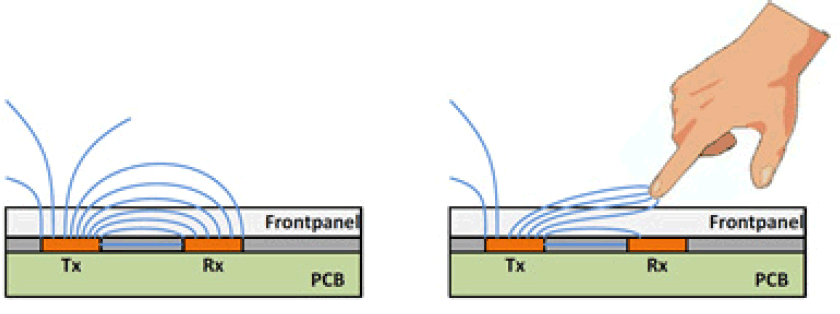SLAU857A May 2021 – July 2021 MSP430FR2476 , MSP430FR2512 , MSP430FR2522 , MSP430FR2532 , MSP430FR2533 , MSP430FR2632 , MSP430FR2633 , MSP430FR2672 , MSP430FR2673 , MSP430FR2675 , MSP430FR2676
2.2 Mutual-Capacitive Detection
As shown in Figure 2-4, mutual-capacitive capacitors use copper-clad double electrodes (receiving electrode Rx, sending electrode Tx) to detect the change in capacitance between the two electrodes. An advantage of mutual-capacitive detection is that the influence of Cp between sensor and power ground can be ignored.
 Figure 2-4 Mutual-Capacitive Detection
Figure 2-4 Mutual-Capacitive DetectionTake the simplest single button as an example, Figure 2-5 shows the detection model of mutual-capacitive capacitor. When touched by a human hand, the CRT becomes two 2CRT, and CRTt, Ct, Ch, and Cg are introduced at the same time. The capacitance between the two electrodes is reduced.
In Figure 2-5, the solid line indicates the PCB routing, and the dashed line indicates the touch-related routing. Gray components indicate equivalent capacitance or resistance.
CRTt = The parallel capacitance between the Rx and Tx electrodes, which is introduced by a finger touch.
CRT = The capacitance between the Rx and Tx electrodes, which is equivalently divided into two capacitances of 2CRT, when touched by a human hand.
The equivalent capacitance between Tx and Rx is shown in Equation 4. Sensitivity can be characterized as the ratio between the capacitance change caused by the touch and the base capacitance, as shown in Equation 5.
For mutual-capacitive touch, the main ways to increase the sensitivity are:
- Reduce the thickness of the cladding layer
- Increase the spacing between Tx and Rx
However, the sensitivity decreases if the finger cannot cover Tx and Rx at the same time.
Generally speaking, for self-inductance and mutual-inductance capacitance detection, the capacitance change caused by a finger touch is approximately 1 pF. But the base capacitance of self-inductance (capacitance value before touch) normally is higher than mutual-capacitance. Therefore, the sensitivity of mutual-capacitive is relatively higher, but it is also more susceptible to noise. From an application point of view, the self-inductance solution is more widely used due to its simple structure, and the mutual-capacitive solution is more used for matrix buttons. Table 2-1 compares the two solutions.
| Features | Self-Capacitive Detection | Mutual-Capacitive Detection |
|---|---|---|
| Difficulty in design and wiring | Simple | Complicated |
| Affected by the grounded metal shell | Yes | No |
| Affected by the ungrounded metal shell | No | Yes |
| Passed CNI test (EMC) level based on the button structure | High level | Low level |
| Support high-density buttons | No | Yes |
| Waterproof and anti-fog performance | Low | High |
| Support metal touch | Yes | No |
| Wheel or slider performance | High resolution | Low resolution |
| Realized proximity sensing distance | >10 cm | <3-4 cm |
| Support touch screen function | No | Yes |